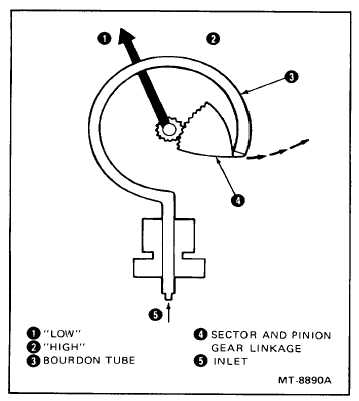S-SERIES INSTRUMENTS
AIR PRESSURE GAUGE
Operation
The air pressure gauges are the mechanical type and
operate on the Bourdon tube principle.
When air system is pressurized, air enters the air
pressure gauge and exerts pressure on the Bourdon
tube. As pressure increases, the Bourdon tube tends to
straighten out and thus actuate the sector and pinion
gear (Figure 22) to which it is attached. This causes
indicator to move across dial in an upscale direction.
When pressure decreases, the Bourdon tube relaxes
and pointer moves in a downscale direction. A steadily
applied air pressure holds the Bourdon tube and pointer
at a fixed scale reading corresponding to applied
pressure.
Figure 22 - Air Pressure Gauge Details
Removal
1.
Detach instrument cluster and cluster bezel.
2.
Unscrew air lines from fittings on rear of the two air
gauge inlets on back of instrument cluster.
3.
Remove gauge mounting screws and demount
gauges from instrument cluster (Figure 23).
4.
Separate
individual
gauges
from
bracket.
Figure 23 - Removing Air Pressure Gauges
Testing
1.
If a suspected gauge has been reading high and
does not return to zero when disconnected, Bourdon
tube has been damaged. Service by replacing with a
new gauge.
2.
If gauge has been reading low or does not read at
all, examine the inlet connection for dirt which might
restrict air from entering gauge. Make a trial
connection and if gauge still does not register
correctly, replace gauge.
NOTE - Always make a comparison test with a gauge
known to be reading correctly before discarding a
questionable gauge.
Installation
Installation of air gauges is the reverse of removal
procedure. Be sure to use non-hardening sealing com-
pound on fitting threads to prevent leaks. Check
installation so as to prevent kinks in air lines.
CTS-4140Y - Page 13



